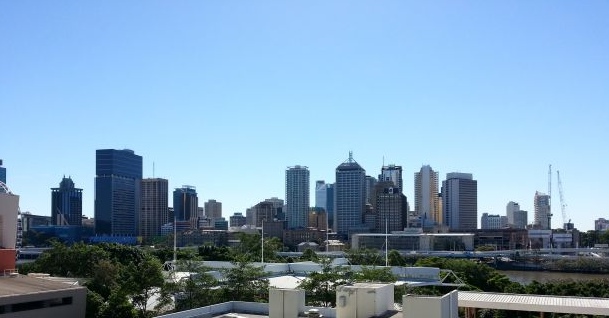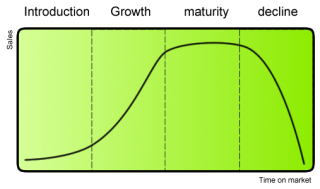On Tuesday 6th May, as part of my week of travel, I was in Brisbane for the Citizen Science Network Australia (CSNA) inaugural workshop. For those that follow me on Twitter, you’d see my micro-blogging of the event under the hashtag #citizenscienceaustralia (or #csna which I preferred due to length).
 It was a beautiful day in Brisbane
It was a beautiful day in Brisbane
Gaia Resources has been supporting the CSNA setup by providing free hosting for the website www.citizenscience.org.au and also by implementing the email list server. We have done this because citizen science has been – and continues to be – an important part of our work, and learning how to better help run citizen science projects and keeping up to date with the movements in this area is important.
The purpose of this workshop was to look at how the CSNA should be set up, and I am very hopeful that a clear path will emerge based on what I saw from the audio booth during the day (I was put to work running the presentations and audio). What also emerged from the day is just how much overlap and replication of work there is in this space.
I think that this is because we are in the early stages of the citizen science “industry” in Australia, and we’re in that shakeup phase, like the introduction area of a product life cycle:
At the moment, citizen science is still an introductory market, and I think we’ll see the shakeout of the various citizen science products and services over time. Personally, I think that one important thing that everyone needs to consider in this early stage – developers, service providers, project managers and citizens – is sustainability. More on that later…
There are a couple of things that I was thinking about in the workshop that I didn’t get to talk about in the panel session I was in, nor comment from the booth, but I managed to post it via a tweet:
 So here’s an explanation of that in more than 140 characters:
So here’s an explanation of that in more than 140 characters:
1. Embrace diversity
Every citizen science project has different aims and groups that use it, so you need to be able to embrace that. There was some discussion about standardising methodologies across projects, and I think that is a bad idea. You need to embrace this diversity, let the methods shake out, and instead document the methods really well so that when we share data you can compare apples with apples.
2. Collaborate to succeed
Citizen science projects need to talk to each other, learn from mistakes and share infrastructure. Importantly, you need to share volunteers and make it easy for them to work with all of our groups. There is a lot of competition at the moment in the citizen science space, because…
3. Collaboration is hard
This is one area that is really hitting home to me lately. I would be as bold as to say that collaboration hasn’t happened often in citizen science for a while and I still saw a lot of jostling for position to ‘own’ citizen science and groups wanting to make their projects the World Dominating Citizen Science project. It seems that there is, however, some good signs with groups starting to talk and collaborate.
So there is a little more explanation of my tweet, and there’s a good example of what I mean in our Coastal Walkabout project.
Coastal Walkabout embraces diversity with the concepts of projects. We are currently running two production projects, the Coastal Walkabout project itself and the Swan River Trust Dolphin Watch project, with the Bunbury Dolphin Discovery Centre ready to launch in a few weeks. There are a range of additional international projects wanting to join up as well!
Each project in the Coastal Walkabout projects embraces diversity by:
- Providing the ability to configure the apps and back end to suit the needs of the project – with us recommending that all observational data use some of the basic attributes in the Darwin Core standard to ensure interoperability,
- A separate ‘survey’ in the underlying BDRS system that separates their data, and provides the back end flexibility to manage their own attributes, and
- A simple project page on the Coastal Walkabout web site so that they can see their data in a live map (like the Coastal Walkabout data page and the Dolphin Watch data map)
 You can download the Coastal Walkabout (iPhone and Android) and DolphinWatch (iPhone and Android) apps now
You can download the Coastal Walkabout (iPhone and Android) and DolphinWatch (iPhone and Android) apps now
The Coastal Walkabout project also collaborates in a few areas;
- All the different projects run on the same infrastructure – so hosting is centralised and costs are shared between projects,
- Everyone signing up for one Coastal Walkabout project can access all of the others with the same login details,
- Allowing anyone to sign up means that the data can be freely downloaded by any interested party, and
- Using Darwin Core style attributes means that the data can be readily mobilised to other systems, groups or even countries.
And of course, collaboration is hard, but by starting with a project that aims to develop into a ‘hub’ where groups can work together, this has made our life a lot easier.
But what does this actually mean in terms of sustainability, the issue I raised at the start of this blog?
The BDRS is an open source package, with the source code available on Google Code. This has enabled projects like the 2012 Koala Count to be run by groups like the NSW Parks Association, who took the code and reworked it themselves with their own developer. Dr. Gráinne Cleary and her team have done a great job on using the BDRS to do this – and I managed to meet Gráinne at the CSNA workshop for the first time to see how they did it.
This proves that the BDRS has a future that is sustainable. There are regular additions to it, we continue to use it in a range of projects and we have recently been looking at the BDRS road maps to look at its future. The BDRS remains a solid part of our stable of products and we use it for a range of projects both internally and commercially, and we’re actively looking at a few of the issues we – and our clients – have identified in it. More on that in another blog, I think!
The future for Coastal Walkabout – and for citizen science projects in general – looks bright. For us, there will be a third project coming on line from the Bunbury Dolphin Discovery Centre in the next few weeks. For any citizen science project in Australia, I expect the CSNA to be formed, to be independent of any one organisation, and to be a voice for best practice, advice and will enable collaboration between groups.
I’m really looking forward to seeing where the next few years takes us in this space.
Piers
P.S. Stay tuned for a second blog this week about the Tipping Point Conference!
Leave me a comment below, start a conversation on the Gaia Resources Facebook page, or get in touch with me via Twitter.


Comments are closed.